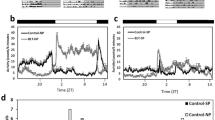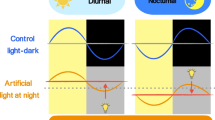Abstract
In this study we investigated the influence of red light, which naturally occurs during dawn and dusk, on locomotor activity and body temperature rhythms of Djungarian hamsters (Phodopus sungarus). A single weak red light pulse given 2 h before regular lights on had acute as well as long-term effects persisting for several days following exposure. The hamsters immediately stopped their locomotor activity, accompanied by a drop in body temperature. In the following undisturbed nights (LD 16∶8) the nocturnal activity stopped earlier than usual. This lasting effect of the light pulse was more pronounced than the acute effect. The activity phase compressed gradually during 3 to 5 days after the light pulse was administered while time of activity onset was almost unaffected. It took 6 to 11 days for complete recovery of the original activity phase. The maximal activity compression and the recovery period depended on the duration of the single red light pulse and its intensity. Red light pulses of 15 min duration were about twice effective as 1 min pulses; and the effect of a red light pulse of 130 mW/m2 was about 1.5 times stronger than a 30 mW/m2 red light pulse. The maximal value of activity phase compression reached in this experiment was 2.5+0.2 h with a recovery period of 11.1±0.3 days following a given red light pulse of 90 mW/m2 and 15 min. The “morning oscillator” seems to be persistently affected. This indicates a very high photosensitivity of the Djungarian hamster's circadian system to red light.
Similar content being viewed by others
Abbreviations
- T b :
-
body temperature
- DD :
-
constant darkness
- LD :
-
light:dark cycle
- LL :
-
constant light
- α:
-
duration of activity phase
- CT :
-
circadian time
- PRC :
-
phase response curve
- SCN :
-
suprachiasmatic nuclei
References
Aschoff J (1964) Die Tagesperiodik licht- und dunkelaktiver Tiere. Rev Suisse Zool 71: 528–558
Aschoff J (1965) Response curves in circadian periodicity. In: Aschoff J (ed) Circadian clocks. North-Holland Publishing Co, Amsterdam, pp 95–111
Axelrod J (1974) The pineal gland: a neurochemical transducer. Science 184: 1341–1348
Benshoff HM, Brainard GC, Rollag MD, Lynch GR (1987) Suppression of pineal melatonin in Peromyscus leucopus by different monochromatic wavelengths of visible and near-ultraviolet light (UV-A). Brain Res 420: 397–402
Binkley S (1983) Circadian rhythms of pineal functions in rats. Endocrine Rev 4: 255–270
Binkley S, Geller E (1975) Pineal enzymes in chickens: development of daily rhythmicity. Gen Comp Endocrinol 27: 424–429
Brainard GC, Richardson BA, Petterborg LJ, Reiter RJ (1982) The effect of different light intensities on pineal melatonin content. Brain Res 233: 75–81
Brainard GC, Richardson BA, King TS, Matthews SA, Reiter RJ (1983) The suppression of pineal melatonin content and Nacetyltransferase activity by different light irradiances in the Syrian hamster: a dose-response relationship. Endocrinology: 113: 293–296
Brainard GC, Richardson BA, Hurlbut EC, Steinlechner S, Matthews SA, King TS, Reiter RJ (1984a) The influence of various irradiances of artificial light, twilight, and moonlight on the suppression of pineal melatonin content in the Syrian hamster. J Pineal Res 1: 105–119
Brainard GC, Richardson BA, King TS, Reiter RJ (1984b) The influence of different light spectra on the suppression of pineal melatonin content in the Syrian hamster. Brain Res 294: 333–339
Brainard GC, Sherry D, Skwerer RG, Waxler M, Kelly K, Rosenthal NE (1990) Effects of different wavelengths in seasonal affective disorder. J Affect Disord 20: 209–216
Daan S, Pittendrigh CS (1976) A functional analysis of circadian pacemakers in nocturnal rodents. II. The variability of phase response curves. J Comp Physiol 106: 253–266
Darrow JM, Goldman BD (1985) Circadian regulation of pineal melatonin and reproduction in the Djungarian hamster. J Biol Rhythms 1: 39–54
Elliott JA, Tamarkin L (1994) Complex circadian regulation of pineal melatonin and wheel-running in Syrian hamsters. J Comp Physiol A 174: 469–484
Figala J, Hoffmann K, Goldau G (1973) Zur Jahresperiodik beim Dsungarischen Zwerghamster Phodopus sungorus Pallas. Oecologia 12: 89–118
Goldman BD (1983) The physiology of melatonin in mammals. Pineal Res Rev 1: 145–182
Gorski T (1976) Red and far red radiation at sunset. Naturwissenschaften 63: 530–531
Grossmann E, Meissl H (1994) Electrophysiology of the suprachiasmatic nucleus (SCN) of the rat: effects of melatonin and diazepam in relation to the circadian phase. Verh Dtsch Zool Ges 87: 131
Heldmaier G, Steinlechner S (1981) Seasonal control of energy requirements for thermoregulation in the Djungarian hamster (Phodopus sungorus), living in natural photoperiod. J Comp Physiol 142: 429–437
Hoffmann K (1973) The influence of photoperiod and melatonin on the testis size, body weight and pelage colour in the Djungarian hamster (Phodopus sungorus). J Comp Physiol 85: 267–282
Hoffmann K (1982) The critical photoperiod in the Djungarian hamster Phodopus sungorus. In: Aschoff J, Daan S, Groos G (eds) Circadian systems: structure and function. Springer, Berlin Heidelberg New York, pp 529–534
Hoffmann K, Illnerová H, Vanecek J (1981) Effect of photoperiod and of one minute light at night-time on the pineal rhythm of N-acetyltransferase activity in the Djungarian hamster (Phodopus sungorus). Biol Reprod 24: 551–555
Illnerová H, Vanecek J, Hoffmann K (1987) Adjustment of the rat pineal N-acetyltransferase rhythm to eight-hour shifts of the light-dark cycle: advance of the cycle disturbs the rhythm more than delay. Brain Res 417: 167–171
Klante G, Steinlechner S (1994) Light irradiance and wavelength as seasonal cues for Djungarian hamsters. Biol Rhythm Res 25: 387–396
Lewy AJ, Kern HA, Rosenthal NE, Wehr TA (1982) Bright artificial light treatment of a manic-depressive patient with a seasonal mood cycle. Am J Psychiat 139: 1496–1498
Mason R, Brooks A (1988) The electrophysiological effects of melatonin and a putative antagonist (N-acetyltryptamine) on rat suprachiasmatic neurones in vitro. Neurosci Lett 95: 296–301
Milette JJ, Turek FW (1986) Circadian and photoperiodic effects of brief light pulses in male Djungarian hamsters. Biol Reprod 35: 327–335
Nuboer JFW, VanNuys WM, VanSteenbergen JC (1982) Colour changes in a light regimen as synchronizers of circadian activity. J Comp Physiol 151: 359–366
Pittendrigh CS, Daan S (1976) A functional analysis of circadian pacemakers in nocturnal rodents. V. A clock for all seasons. J Comp Physiol 106: 333–355
Puchalski W, Lynch GR (1991a) Expression of circadian rhythmicity in Djungarian hamsters under constant light: effects of light intensity and the circadian system's state. J Comp Physiol A 169: 185–189
Puchalski W, Lynch GR (1991b) Circadian characteristics of Djungarian hamsters: effects of photoperiodic pretreatment and artificial selection. Am J Physiol 261: R670-R676
Rea MA (1992) Different populations of cells in the suprachiasmatic nuclei express c-fos in association with light-induced phase delays and advances of the free-running activity rhythm in hamsters. Brain Res 579: 107–112
Reiter RJ (1981) The pineal gland: structure and function. Am J Anat 162: 287–313
Reiter RJ (1985) Action spectra, dose-response relationships and temporal aspects of light's effects on the pineal gland. Ann NY Acad Sci 453: 215–230
Ruf T, Heldmaier G (1987) Computerized body temperature telemetry in small animals: use of simple equipment and advanced noise suppression. Comput Biol Med 17: 331–340
Rusak B, Zucker I (1979) Neural regulation of circadian rhythms. Physiol Rev 59: 449–526
Rusak B, Robertson HA, Wisden W, Hunt SP (1990) Light pulses that shift rhythms induced gene expression in the suprachiasmatic nucleus. Science 248: 1237–1240
Stehle J, Vanecek, Vollrath L (1989) Effects of melatonin on spontaneous electrical activity of neurons in rat suprachiasmatic nuclei: an in vitro iontophoretic study. J Neural Transm 78: 173–177
Steinlechner S, Buchberger A, Heldmaier G (1987) Circadian rhythms of pineal N-acetyltransferase activity in the Djungarian hamster, Phodopus sungorus, in response to seasonal changes of natural photoperiod. J Comp Physiol A 160: 593–597
Steinlechner S, Bärwinkel U, Körtge A, Klante G (1994) Acute and long-term effects of light pulses on circadian rhythms of Djungarian hamsters and chickens: Animal models for light therapy of winter depression? Verh Dtsch Zool Ges 87.1: 200
Thorington L (1985) Spectral, irradiance, and temporal aspects of natural and artificial light. Ann NY Acad Sci 453: 28–54
Vanecek J, Illnerová H (1982) Night pineal NAT in rats exposed to white or red light pulses of various intensity and duration. Experientia 38: 1318–1320
Wurtman RJ, Baum MJ, Potts JT (1985) The medical and biological effects of light. Ann NY Acad Sci 453: 1–408
Author information
Authors and Affiliations
Rights and permissions
About this article
Cite this article
Klante, G., Steinlechner, S. A short red light pulse during dark phase of LD-cycle perturbs the hamster's circadian clock. J Comp Physiol A 177, 775–780 (1995). https://doi.org/10.1007/BF00187636
Accepted:
Issue Date:
DOI: https://doi.org/10.1007/BF00187636




